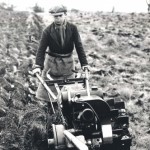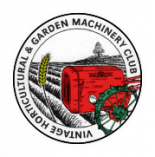Forum Replies Created
-
AuthorPosts
-
December 22, 2014 at 8:48 pm #11156
 trusty220Keymaster
trusty220KeymasterWith the crankshaft out of the engine I felt it wouldn’t hurt to put a dial gauge on the crankshaft to make sure it is true. Not such a silly statement, because the crank is made in five separate parts which are bolted and clamped together; the main items are the crank webs which are also the flywheels, and these are held together by the big-end crankpin. This crankpin has a male thread on each end which projects through each flywheel, then a large nut on the outside is tightened to hold it all together. The only trouble is there is no keyway in either end of the crankpin, so the flywheels are free to move as the nuts are tightened. The only way to adjust them is to loosen the nut on one side and knock the flywheel half with a large piece of wood until the flywheels run true to each other. It is impossible to get them exactly lined up, but a run-out of 5 thou is acceptable.
With the main bearing stubs located, the easy way to do it is shown in the pictures. You need to hold the two ends of the crank and rotate it slowly by hand whilst holding a dial gauge against one side, then adjust and repeat for the other side. If you don’t have a handy lathe you can always use a pair of V-blocks.December 22, 2014 at 3:03 pm #11148 trusty220Keymaster
trusty220KeymasterThe price list advertised them with spade lugs only, or with spade lugs and pneumatics. Apparently they had quite a stockpile of steel wheels when the factory closed, so maybe they were trying to get rid of them in the 50’s and 60’s.
Here’s a photo of a Mk2 on steels- it’s a factory photo from the 50’s.December 7, 2014 at 5:32 pm #10983 trusty220Keymaster
trusty220KeymasterJust a quick update to say that I have now taken the two halves of the crankcase apart and de-greased them, but unfortunately no photo’s to show.
I’ve had a bit of a break from it this week because someone tried to break in to the workshop at work on Saturday and I’ve spent most of my weekend trying to secure it again- one of the joys of being a manager and a keyholder, I suppose.
Business as usual next week, all being well!November 30, 2014 at 9:20 pm #10882 trusty220Keymaster
trusty220KeymasterWhy, what have you done with the chicken???
November 30, 2014 at 6:50 pm #10880 trusty220Keymaster
trusty220KeymasterDid you find any, granddad? Would you like me to turn some up for you?
November 30, 2014 at 6:47 pm #10878 trusty220Keymaster
trusty220KeymasterThe circular plate that you mention was an optional extra that was supplied by the factory, particularly to prevent dust and dirt contaminating the felt seal. They were known as Dust Shields and you can use them to overcome the pitting on an old wheel if you don’t feel like replacing the centres.
November 30, 2014 at 5:11 pm #10865 trusty220Keymaster
trusty220KeymasterNow we have to get into the timing gears, so the first bit is to use the puller again to take off the second sprocket on the timing chain. Same procedure as before, normal right-hand thread on the nut and then the sprocket is on another of those tapers. If this one won’t budge you can give it a tap with a hammer, but not too hard otherwise you may damage the thread.
Once that is off, undo the ring of screws around the outside (mine were all seized solid) and the two in the timing case and the cover should lift off. Beware that there is a little brass thimble with a spring behind it on the outlet of the oil pump that is easy to drop on the floor and lose; make sure that you put it somewhere safe straightaway!
The oil pump is simply detached by undoing the two nuts holding it on; the scroll that drives the oil pump is a left hand thread, and if you wipe off the surface you will see a little arrow and the word “unscrew”. Turn clockwise to undo it and remove it- I used a small brass centre punch to get it moving so that it wouldn’t hurt the metal- then lift off the gears with their cams attached. That only leaves the centre drive gear which is keyed to the crankshaft- again, use the puller and remove this.
Next thrilling instalment soon!November 30, 2014 at 4:58 pm #10861 trusty220Keymaster
trusty220KeymasterSorry for the delay, but here’s the next stage. I don’t think this engine has ever been apart and it’s been fighting me all the way, making me use all the cunning tricks that I’ve learnt over the years messing with all sorts of machinery.
First item to remove is the cylinder barrel. On the Steed the engine is more like the motorbike engine with a separate aluminium valve chest- on the 2-wheeler the valve chest is cast into the cylinder casting- and there is a valve lifter incorporated into the valve chest alongside the exhaust valve. The easiest way to dismantle it all is to unscrew the valve lifter as an assembly so that it doesn’t foul anything as you lift the barrel off. The valve chest won’t come off until you undo the exhaust tappet adjuster and remove the washer underneath- this is what the valve lifter pushes up. Once the washer is off the casting will then pass over the cam followers.
Now the one everyone hates- the magneto! It is very simple to remove in the book, but then the people who write the books very rarely have to do the job! Remove the three screws from the timing chain cover and remove the cover. You can now see the two sprockets with an endless chain between them. Don’t bother looking for a joining link because there isn’t one, the chain is fitted when the sprockets are put on. Starting with the magneto sprocket, undo the nut holding it on (it is a normal right-hand thread, so it ondoes anticlockwise). The sprocket will still not come off because it will be locked on a taper. At this stage do not be tempted to put a lever behind it because you will only damage the magneto internally; the correct way to remove the sprocket is to use a small puller. You can see the idea in the photo, with the legs pulling the sprocket and the centre screw pushing back on the armature spindle; to protect the threads on the spindle I have refitted the nut loosely until it is flush with the end of the thread, then put a steel plate over the spindle to take the bruising from the screw. Tighten the screw, apply a little heat as necessary to the sprocket and it should pop off. Try to avoid hitting the end with a hammer because you may damage the bearings in the mag.
All that you need to do now is to undo the bolt that is holding the magneto platform to the engine mount and the magneto can be taken off. Beware that it does look like there are two bolts holding it on, but the one closest to the engine is passing through the crankcase and not the magneto platform.November 23, 2014 at 7:42 pm #10809 trusty220KeymasterNovember 23, 2014 at 6:58 pm #10804
trusty220KeymasterNovember 23, 2014 at 6:58 pm #10804 trusty220Keymaster
trusty220KeymasterI’d forgotten what a job it is to remove the engine on these beasties. As you can see from the pictures the fan housing has to come off, followed by the fans and the fan carrier so that the crankshaft will fit through the side plate.
Ideally it would be great to slide the engine and gearbox as one assembly out of the front of the chassis, but that won’t happen unless you take the clutch assembly off. I opted for the easy way out and took the gearbox off it’s mounting plate so that the engine will come out by itself with all of the mountings in place.
You can see where the gearbox fits from the one photo- it goes on the flat plate at the rear of the engine, and you can tension the engine>gearbox chain by pivoting the carrier downwards using the jacking post at the top.
See if you can spot the section of railway line that I use as an anvil. It fell over this afternoon and dug a hole in my ankle, making me swear and starting the wife nagging me to go to A&E! Typical bloke’s cure- sit in front of telly with a glass of something strong that will knock me out when I go to bed.
Tomorrow’s another day!November 22, 2014 at 5:37 pm #10794 trusty220Keymaster
trusty220KeymasterThanks for that, Alan; I do have a workshop manual for this engine, but many of our members would appreciate it I’m sure.
I will get down to some more dismantling on Sunday and (hopefully) uncover the engine number.November 21, 2014 at 8:48 am #10780 trusty220Keymaster
trusty220KeymasterI will be pleased to include the Jalo history in the “Survivors” section when you’re ready, Ivan. It is already building into a very useful archive and any information that we can include in there (on any make of machinery) will be welcomed.
Please would everybody support Ivan with information for this little project.
Thank you, All.
November 20, 2014 at 9:56 pm #10776 trusty220Keymaster
trusty220KeymasterFirst bits to come off are the fuel tank, supports, cowling and cylinder head. The engine on this Steed is the Norton Big Four which is a single cylinder 600cc four stroke with a dry sump.
Non standard parts so far are the tank straps (someone has used large jubilee clips) and the home-made exhaust silencer and support. These will have to be sorted at the rebuild stage.An unusual feature of this engine is the way that the cooling fins on the cylinder head have been machined to provide a flat top surface for the cowling; because some of the fin area has been reduced, the factory has machined grooves across the head to increase the surface area.
November 18, 2014 at 5:13 pm #10747 trusty220Keymaster
trusty220KeymasterOi- it definitely wasn’t me! I was out looking for pork scratchings at the time and came back to find that all the fuss was over and done with.
November 12, 2014 at 9:34 pm #10672 trusty220Keymaster
trusty220KeymasterI have turned solid ones up from aluminium in the past and they work just as well.
-
AuthorPosts

















